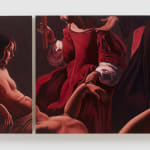-
Artworks








The Magic Chamber, 2021
Oil on cottonDiptych
Overall: 40 x 84 in.
101.6 x 213.4 cmSoldFurther images
-
(View a larger image of thumbnail 1
)

-
(View a larger image of thumbnail 2
)

-
(View a larger image of thumbnail 3
)

-
(View a larger image of thumbnail 4
)

-
(View a larger image of thumbnail 5
)

-
(View a larger image of thumbnail 6
)

-
(View a larger image of thumbnail 7
)

-
(View a larger image of thumbnail 8
)

The Magic Chamber is taken from an act of the musical play 'Le Martyre de Saint Sebastien,' written in 1911 by Gabriele D'Annunzio, with music by Claude Debussy, with Saint...The Magic Chamber is taken from an act of the musical play "Le Martyre de Saint Sebastien," written in 1911 by Gabriele D'Annunzio, with music by Claude Debussy, with Saint Sebastian played by a female actor. In my work two moments from different historical references are married across the divide of the diptych. The androgynous Sebastian on the left panel of my work gazes at another version of Sebastian being cared for on the right panel. In this way, the painting represents the body traversing its physical boundaries, the small gap between panels creating a kind of magical space where time and the self pass outside our laws. The borrowing of the title "The Magic Chamber" from the play layers a third iteration of the Saint Sebastian story onto the work, and refers to the non-space the figures in my painting inhabit as a magical space in which the boundaries of time, gender, and the body dissolve.
The historical references are two different paintings by Georges De la Tour of Saint Sebastian being tended by Saint Irene. I became interested in Saint Sebastian when I learned that he is the patron saint of plague, and that the beauty of his historical depiction developed after the Black Death and his subsequent association with health. Over time, the meaning of Saint Sebastian's representation has expanded far beyond its original story of Christian martyrdom, and come to suggest hope of recovery from illness, which lead to an eroticization of his youthful image, which led to his becoming a symbol of homoeroticism and then revived as a symbol of hope during the AIDS movement. In referencing art history in my work, I am particularly interested in the ever-evolving meaning attached to images, how they transform over time and across culture, and how the act of bringing them into our present context expands their resonance now.
-
(View a larger image of thumbnail 1
)







